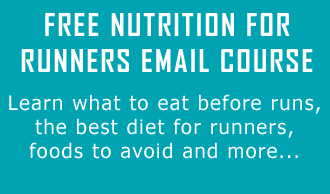Periodization is a long-term, progressive approach to training designed to improve athletic performance by systematically varying training throughout the year. The ultimate goal of training periodization is to achieve peak performance at the most important time in the season. This could be a goal half marathon, the Boston Marathon, or even the Olympic Trials.
To achieve that goal, a typical training year for a runner can usually be broken down into four cycles: the preparation cycle, the build cycle, the race cycle, and the transition cycle. While coaches may call these cycle different names, a constant fact is that each cycle has a different physiologic goal and thus the training will vary in volume, intensity, and specificity depending on the cycle.
In this article I will describe the physical training load a typical runner would face in each cycle of training and I will also give guidelines on how to match nutrition periodization with that training in order to get the most out of your season.
The preparation cycle
The first cycle of a new training season is usually the preparation cycle. Runners may more commonly refer to this as “base mileage”. Training during this cycle typically includes long endurance runs at a low to moderate intensity with the purpose of developing aerobic capacity and fitness (endurance), building muscular strength, and increasing flexibility to support the more intense training encountered in the next cycle. Depending on when you start your season and when your goal races are, this cycle can last about 16-20 weeks.
If you are attempting to lose weight/body fat, this is the training cycle to do it in. Since workouts are not as intense, you can afford to have an energy deficit without compromising performance.
Just be sure to lose weight safely and try to achieve your weight loss goal in the early part of this cycle.
Preparation cycle nutrition goals
During this cycle your body will get its fuel from a somewhat even mix of carbohydrates and fat so it is important to have adequate amounts of both macronutrients in your diet. If you are trying to gain lean muscle through a strength-training plan, your protein needs may be slightly elevated. The following are some general guidelines for this cycle:
| g/kg | Ex. for 130 lb runner | |
| Carbohydrate | 5-7 for low to moderate training | 295-413 g/day |
| 7-10 for moderate to heavy training | 413-591 g/day | |
| Protein | 1.2-1.7 | 71-100 g/day |
| Fat | 0.8-1.0 | 47-59 g/day |
| Avg. 2,235 calories/day |
Since workouts and training runs are not very high intensity yet, runners don’t have to worry much about consuming a pre-exercise snack so long as they consume a good meal in the hours before training.
At the same time, however, it is also a good idea to practice with a number of different nutritional products during this cycle to determine which ones you will use during training and competition. Find out which bars, gels, and/or drinks you like best (flavor, texture, etc.) and how your body reacts to those products during training (GI symptoms, burst of energy, etc.).
Finally, experiment with new foods during this cycle and avoid getting into “food ruts”. This is a good opportunity to balance out your diet with more variety in each of the food groups.
The build cycle
In the last few weeks of the preparation cycle your training intensity will probably start to increase as you get ready for the “meat” of your training. The build cycle has also been called the pre-race cycle or the specific preparation cycle.
During this time the intensity of your training runs will increase while your volume stays the same or perhaps decreases slightly. The purpose of this training cycle is to improve your VO2max as well as your body’s ability to clear lactate (lactate threshold).
Common workouts during this cycle include threshold runs, intense interval sessions, and speed/technique workouts like hill repeats. This cycle typically lasts 8-12 weeks, again depending on the timing of your goal race(s), and often includes a number of less important races that help in preparing you for the big one(s).
Energy expenditure is very high during the build cycle. Therefore, recovery nutrition is crucial so it is not advised to attempt weight loss during this season. Weight loss or inadequate nutritional recovery could result in reduced glycogen repletion, loss of lean body mass, decreased energy for workouts, and even injury.
Build cycle nutrition goals
Carbohydrate intake is important during this time to support the increase in training intensity. Furthermore, protein needs will be higher due to the stress that high-intensity training places on your muscles. The following are some general guidelines for this cycle:
| g/kg | Ex. for 130 lb runner | |
| Carbohydrate | 7-13 | 413-768 g/day |
| Protein | 1.4-2.0 | 83-118 g/day |
| Fat | 0.8-1.0 | 47-59 g/day |
| Avg. 3,241 calories/day |
During this cycle you should be consuming pre-exercise snacks and be practicing your in-competition fueling with the products you plan to use on race day. In addition, adequate recovery from workouts is dependent on proper recovery nutrition. Finally, it is important to eat and hydrate often in order to maintain glycogen stores as well as proper fluid and electrolyte balance.
The race cycle a.k.a. the competition cycle
The race cycle is marked by a significant decrease in training volume and intensity as you enter the part of the season you have been training for. This is where your most important competitions fall in your training year, so the length of this cycle depends on the length and number of your competitions.
For a lot of runners the race cycle will coincide with the build cycle as one will taper for a race, compete, and then return to build cycle workouts in preparation for the next race. However, the main goals during the race cycle are to improve race performance and times and also recover quickly to move on to the next workout or race.
Race cycle nutrition goals
Once a runner enters the competition cycle, intensity of training will remain high but training volume will likely decrease. Therefore nutrition goals are very similar to those in the build cycle and it is important to match energy intake with energy expenditure.
During this time we are told that “the hay is in the barn,” meaning that we have done all the work we can do, now it is time to execute our race plan and let our training pay off. The same is true with nutrition. The work is done, we just need to follow our pre-race and race day nutrition plans and watch our nutrition training from the past cycles pay off.
There are a few things you can do nutritionally during this cycle that will have an impact on your performance.
- The first is pre-race carbohydrate loading, which can be an effective strategy for races lasting longer than 90 minutes.
- The second is following your in-competition fueling plan that you have been practicing during your training.
- And finally, it is beneficial to focus on good post-race recovery nutrition so that you give yourself a headstart in preparation for the next race.
The transition cycle
After a successful track season or a new marathon PR, it is time for some much needed rest and recovery. Your body may need 2-4 weeks of absolute rest with minimal running or working out after a long and intense race like the marathon or an Ironman, or even after many weeks of back-to-back track races. The transition cycle may last another 4-12 weeks depending on the start of your next season.
It is important to let your body recover to avoid injury, or perhaps to heal an injury that occurred during an earlier cycle. At the same time, you want to try to maintain a base level of aerobic conditioning for when you are ready to transition back into the preparation cycle.
Since the volume and intensity of training are lower at this time than during any other cycle, the biggest concern is unwanted weight gain. If you do not decrease caloric intake to match your decrease in training, weight gain will likely occur.
Transition cycle nutrition goals
The end of a long and hopefully successful season is often a time of celebration. You deserve to treat yourself as much as you deserve a break from training. Just remember to practice some judgment and moderation in your nutrition choices. The following are some basic guidelines for transition cycle nutrition:
| g/kg | Ex. for 130 lb runner | |
| Carbohydrate | 5-6 | 295-355 g/day |
| Protein | 1.2-1.4 | 71-83 g/day |
| Fat | 0.8-1.0 | 47-59 g/day |
| Avg. 2,085 calories/day |
If you had been restricting certain foods or food groups during training and racing, now would be a good time to reintroduce those foods to your diet.
To make up for the decrease in calories you are expending, it would also be wise to eliminate the bars, gels, and sports drinks from your diet as you don’t need those during this cycle.
Finally, as in the preparation cycle, try new foods and add some nutritional variety to your diet. You may just find something truly great that you’ve been missing out on.
RunnersConnect Bonus Extra
Get the only runner’s calorie calculator that factors in your metabolism and the miles you ran to help you determine exactly how many calories you burned each day. Plus, get a breakdown of how many calories you need to eat (including how many carbs, proteins and fats you should target) to lose weight.
Sports Nutrition: A Practice Manual for Professionals, 4th ed. American Dietetic Association; 2006. Frankenfield, DC.









2 Responses
I am 5’10, 143, pounds and I am in the build cycle of my training and I am trying to lose weight. Am I a healthy weight and should I not worry about trying to lose? Before I saw this I was eating anywhere between 1500-to 2000 calories a day. My carbs are almost always under 200. I have been feeling sluggish throughout my workouts as well. I am a highschool senior who wants to break 16 in the 5k. How important are carbs and how many should I get for my recovery, hard, and moderate days?
Carbohydrates are the most important fuel and your low intake of calories and carbohydrates is likely a reason for the “sluggish” feeling you are having during workouts. I am not sure what you mileage is, but an athlete of your size and activity level will need at least 325 grams of carbohydrate a day, more on harder and longer workout days, and probably at least 2500 calories per day. Again, I don’t know your specifics but the numbers you have given me for calories and carbohydrate do not seem like enough to support your training.